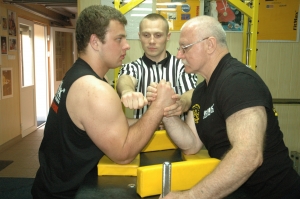In answer to the beginners’ questions (and as a reminder to the seasoned pros) we’d like to present to you the basic rules to apply when competing. We’d like to touch upon the subject of the setting before the fight.
All commands from referee to contestant are uttered in English. This applies to national and international events. This allows the referees much more ease whenever they are needed.
PROPER SETTING BEFORE A FIGHT


Upon approaching the table, a contestant should greet their opponent and assume the starting position. On the referee’s command “Put elbows on the table” the opponents assume the position and place their elbows on the table pads, with their hands gripped in the center of the table (palm to palm, thumb around thumb). The elbow can be placed on any part of the elbow pad. The other hand must grip the table’s grip.


Shoulders must be placed along the edge of the table. The shoulder and head cannot cross the table middle line at any moment of the fight. Before the start, the distance between shoulder and forearm cannot be larger than a palm’s width. The same applies to the distance between chin and fighting arm.



The knuckles of the fighting arms must be visible at all times, wrists must be kept straight. If one or both contestants cannot reach a comfortable grip within the space of 60 seconds by themselves, a “Referee’s grip” is then applied. The referee sets the opponents accordingly and none of them can then move until the start. Any move on the part of a contestant is considered a foul.


In the case of referee’s grip, the referee sets up the grip in the middle of the table and then the shoulders, finishing with the “don’t move” command. Then they set up the fingers and thumbs, asking the contestants what grip they prefer (thumbs covered or uncovered). Then they check if the forearms are not pronated. In any case (normal grip or referee’s grip), the fight can start only after “Ready, Go!”
Piotr Szczerba

